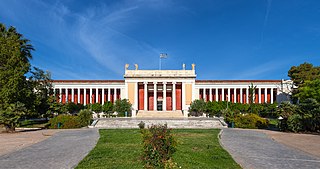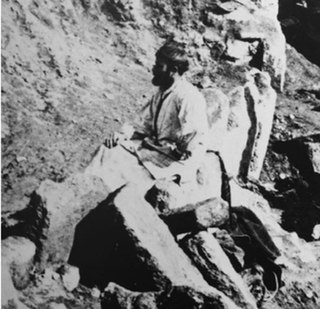
Aegean civilization is a general term for the Bronze Age civilizations of Greece around the Aegean Sea. There are three distinct but communicating and interacting geographic regions covered by this term: Crete, the Cyclades and the Greek mainland. Crete is associated with the Minoan civilization from the Early Bronze Age. The Cycladic civilization converges with the mainland during the Early Helladic ("Minyan") period and with Crete in the Middle Minoan period. From c. 1450 BC, the Greek Mycenaean civilization spreads to Crete, probably by military conquest. The earlier Aegean farming populations of Neolithic Greece brought agriculture westward into Europe before 5,000 BC.

Johann Ludwig Heinrich Julius Schliemann was a German businessman and an influential amateur archaeologist. He was an advocate of the historicity of places mentioned in the works of Homer and an archaeological excavator of Hisarlik, now presumed to be the site of Troy, along with the Mycenaean sites Mycenae and Tiryns. His work lent weight to the idea that Homer's Iliad reflects historical events. Schliemann's excavation of nine levels of archaeological remains has been criticized as destructive of significant historical artifacts, including the level that is believed to be the historical Troy.

Troy or Ilion was an ancient city located in present-day Hisarlik, Turkey. It is best known as the setting for the Trojan War. The archaeological site is open to the public as a tourist destination, and was added to the UNESCO World Heritage list in 1998.

The Iraq Museum is the national museum of Iraq, located in Baghdad. It is sometimes informally called the National Museum of Iraq, a recent phenomenon influenced by other nations' naming of their national museums; The Iraq Museum's name is inspired by the name of the British Museum, however. The Iraq Museum contains precious relics from the Mesopotamian, Abbasid and Persian civilizations. It was looted during and after the 2003 Invasion of Iraq. Despite international efforts, only some of the stolen artifacts have been returned. After being closed for many years while being refurbished, and rarely open for public viewing, the museum was officially reopened in February 2015.

The National Museum of Afghanistan is a two-story building located across the street from the Darul Aman Palace in the Darulaman area of Kabul, Afghanistan. It was once considered to be one of the world's finest museums. There have been reports about expanding the museum or building a new larger one.

Wilhelm Dörpfeld was a German architect and archaeologist, a pioneer of stratigraphic excavation and precise graphical documentation of archaeological projects. He is famous for his work on Bronze Age sites around the Mediterranean, such as Tiryns and Hisarlik, where he continued Heinrich Schliemann's excavations. Like Schliemann, Dörpfeld was an advocate of the historical reality of places mentioned in the works of Homer. While the details of his claims regarding locations mentioned in Homer's writings are not considered accurate by later archaeologists, his fundamental idea that they correspond to real places is accepted. Thus, his work greatly contributed to not only scientific techniques and study of these historically significant sites but also a renewed public interest in the culture and the mythology of Ancient Greece.

Frank Calvert (1828–1908) was an English expatriate who was a consular official in the eastern Mediterranean region and an amateur archaeologist. He began exploratory excavations on the mound at Hisarlik, seven years before the arrival of Heinrich Schliemann.

Huaca Rajada, also known as Sipán, is a Moche archaeological site in northern Peru in the Lambayeque Valley, that is famous for the tomb of Lord of Sipán, excavated by Walter Alva and his wife Susana Meneses beginning in 1987. The city of Sipán is dated from 50–700 AD, the same time as the Moche Period.

The Mask of Agamemnon is a gold funerary mask discovered at the Bronze Age site of Mycenae in southern Greece. The mask, displayed in the National Archaeological Museum of Athens, has been described by the historian Cathy Gere as the "Mona Lisa of prehistory".

The National Archaeological Museum in Athens houses some of the most important artifacts from a variety of archaeological locations around Greece from prehistory to late antiquity. It is considered one of the greatest museums in the world and contains the richest collection of Greek Antiquity artifacts worldwide. It is situated in the Exarcheia area in central Athens between Epirus Street, Bouboulinas Street and Tositsas Street while its entrance is on the Patission Street adjacent to the historical building of the Athens Polytechnic university.

The historicity of the Iliad has been a topic of scholarly debate for centuries. While researchers of the 18th century had largely rejected the story of the Trojan War as fable, the discoveries made by Heinrich Schliemann at Hisarlik reopened the question. The subsequent excavation of Troy VIIa and the discovery of the toponym "Wilusa" in cuneiform Hittite correspondence has made it plausible that the Trojan War cycle was at least remotely based on a historical conflict of the 12th century BC, even if the poems of Homer remembered the event only through the distortion of four centuries of oral tradition.

Ithaca was, in Greek mythology, the island home of the hero Odysseus. The specific location of the island, as it was described in Homer's Odyssey, is a matter for debate. There have been various theories about its location. Modern Ithaca has traditionally been accepted to be Homer's island. One recent alternative candidate is Paliki, which may have been an island separated from the rest of Kefalonia, as argued by Bittlestone, Diggle and Underhill in Odysseus Unbound. This theory, however, has not been generally accepted on grounds of geology, archaeology, philology, or historical and Homeric analysis. “What is clearly missing,” wrote Dr Christine Haywood reviewing Odysseus Unbound, “is a good knowledge of the complexities of Homeric language, and the support of archaeology.”

Looted art has been a consequence of looting during war, natural disaster and riot for centuries. Looting of art, archaeology and other cultural property may be an opportunistic criminal act or may be a more organized case of unlawful or unethical pillage by the victor of a conflict. The term "looted art" reflects bias, and whether particular art has been taken legally or illegally is often the subject of conflicting laws and subjective interpretations of governments and people; use of the term "looted art" in reference to a particular art object implies that the art was taken illegally.

The Eberswalde Hoard or Treasure of Eberswalde is a Bronze Age hoard of 81 gold objects with a total weight of 2.59 kg (83 ozt). The largest prehistoric assembly of gold objects ever found in Germany, it is considered to be one of the most important finds from the Central European Bronze Age. Its production has been attributed to the Nordic Bronze Age culture. Today, it is in Russia, as part of the group of artifacts and works of art looted from Germany at the end of the Second World War.

"The Spoils of War—World War II and Its Aftermath: The Loss, Reappearance, and Recovery of Cultural Property" was an international symposium held in New York City in 1995 to discuss the artworks, cultural property, and historic sites damaged, lost, and plundered as a result of World War II. The three-day event was sponsored by the Bard Graduate Center for Studies in the Decorative Arts to commemorate the 50th anniversary of the end of the war. The conference was organized by Elizabeth Simpson, an archaeologist and professor at the Bard Graduate Center.

Sophia Schliemann, born Sophia Engastromenou was the Greek second wife of the businessman and amateur archaeologist Heinrich Schliemann. She is known for posing for a photo while draped in gold jewelry from the Treasure of Priam.

Clytemnestra, also known as Clytemnestra after the Murder, is an 1882 oil painting by John Collier. It has been held by the Guildhall Art Gallery, in the City of London, since 1893. A second version, c. 1914, is held by Worcester City Art Gallery & Museum.

Panagiotis Antoniou Stamatakis was a Greek archaeologist. He is noted particularly for his role in supervising the excavations of Heinrich Schliemann at Mycenae in 1876, and his role in recording and preserving the archaeological remains at the site.

Athanasios Sergiou Rhousopoulos was a Greek archaeologist, antiquities dealer and university professor. He has been described as "the most important Greek collector and dealer between the 1860s and 1890s", and as "a key figure in the early days of archaeology in Greece."





















